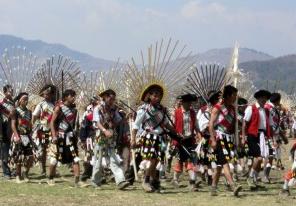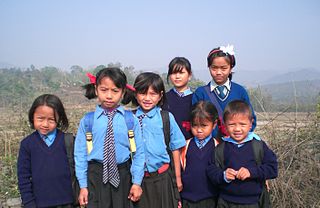Related Research Articles

Nagaland is a landlocked state in the north-eastern region of India. It is bordered by the Indian states of Arunachal Pradesh to the north, Assam to the west, Manipur to the south, and the Naga Self-Administered Zone of the Sagaing Region of Myanmar (Burma) to the east. Its capital city is Kohima and its largest city is the twin Chümoukedima–Dimapur. The state has an area of 16,579 square kilometres (6,401 sq mi) with a population of 1,980,602 as per the 2011 Census of India, making it one of the smallest states of India.
The Indian state of Arunachal Pradesh has a total population of roughly 1.4 million on an area of 84,000 km2, amounting to a population density of about 17 pop./km2. The "indigenous groups" account for about two thirds of population, while immigrants, mostly of Bengali/Hindi belt origin, account for the remaining third.

The Wancho people, also known as the Wancho Naga, are a Tibeto-Burmese indigenous ethnic group inhabiting the Patkai hills of Longding district in the Northeast Indian state of Arunachal Pradesh. The Wancho language belongs to the Tibeto-Burman family under Northern Naga languages.

Nagas are various ethnic groups native to northeastern India and northwestern Myanmar. The groups have similar cultures and traditions, and form the majority of population in the Indian state of Nagaland and Naga Self-Administered Zone of Myanmar (Burma); with significant populations in Manipur, Arunachal Pradesh and Assam in India; Sagaing Region and Kachin State in Myanmar.
The Angamis are a major Naga ethnic group native to the Northeast Indian state of Nagaland.
The Aos are a major Naga ethnic group native to Mokokchung District of Nagaland in Northeast India. Their main territory is from Tsüla (Dikhu) Valley in the east to Tsürang (Disai) Valley in the west in Mokokchung District.

Senapati, is one of the 16 districts of the Indian state of Manipur. The present Senapati district was formed in December 2016, after spawning off the Sadar Hills region in the south into a separate Kangpokpi district. The district headquarter is located in the municipality of Tahamzam.

Zünheboto District (Pron:/ˌzʌnˈhiːbəʊtəʊ/) is a district in the Indian state of Nagaland. Sümi Nagas are indigenous to this district.

The Naga conflict, also known as the Naga Insurgency, is an ongoing conflict fought between the ethnic Nagas and the governments of India in northeastern India. Nagaland, inhabited by the Nagas, is located at the tri-junction border of India on the West and South, north and Myanmar on the East.

The Poumai people, also known as the Poumai Naga, are a Tibeto-Burman ethnic group that inhabit the Northeast Indian states of Manipur and Nagaland. The Poumai predominantly live in the Senapati District of Manipur, though there are villages in Nagaland state and one in Ukhrul district. The Poumai mainly live in 100 villages that have been broadly divided into three blocks: Paomata, Lepaona and Chilivai. The Poumai speak their own language, Poula, and are generally Christian.

Kiphire District (Pron:/ˈkɪfɑɪə/) is a district in the Indian state of Nagaland. It is native to the Sangtam Nagas. At 1,130 square kilometres (440 sq mi), as of 2011 the district is the tenth-most populous district of Nagaland. It was craved out of Tuensang district becoming a district in 2004 along with Longleng district. Headquartered at Kiphire town, the district is 230 kilometres from state-capital Kohima.
The Rengma Naga are a Tibeto-Burman ethnic group inhabiting the Northeast Indian states of Nagaland and Assam. According to the 2011 Census of India, the population of Rengmas in Nagaland stands at 62,951 and the population of Rengmas in Assam is around 22,000. Tseminyü District is the headquarters of the Rengmas in Nagaland and the headquarters of the Rengmas in Assam is located at Phentsero/Karenga Village.
Yimkhiungrü is a Sino-Tibetan language spoken in northeast India by the Yimkhiung Naga people. It is spoken between Namchik and Patkoi in Shamator District, Nagaland, India. Yimkhiungrü language has more than 100,000 speakers and is used in over 100 villages and towns.
The Khiamniungans are a Naga ethnic group, with approximately 35% of the population inhabiting in Noklak District in the Northeast Indian state of Nagaland and the rest in the Naga Self-Administered Zone and Hkamti District of Myanmar. They were also called Kalyo-Kengnyu during the British Raj.
The largest religion in Nagaland is Christianity. The state's population is 1,978,502, as of 2011, out of which 87.93% are Christians. The 2011 census recorded the state's Christian population at 1,745,181, making it, with Meghalaya, Arunachal Pradesh, and Mizoram as the four Christian-majority states in India. The state has a very high church attendance rate in both urban and rural areas. The majority of churches are found in Kohima, Chümoukedima, Dimapur and Mokokchung.

The hill tribes of Northeast India are hill people, mostly classified as Scheduled Tribes (STs), who live in the Northeast India region. This region has the largest proportion of scheduled tribes in the country.
The Tikhirs are a Naga ethnic group inhabiting the Northeast Indian state of Nagaland. According to the 2011 census, the population of the Tikhir people in Nagaland was 7,537. They are recognised as a Scheduled Tribe (STs) by India.
The Makury tribe is one of the Naga tribes that mostly resides in Naga Self-Administered Zone in Myanmar and some in Nagaland, India. They are one of the major Naga tribes of Myanmar and mostly inhabits around Lay Shi Township in Myanmar. However, in India due to lack of official recognition from Government of Nagaland are considered sub-tribe of Yimkhiung Nagas.

Shamator District is the 16th district of the Indian state of Nagaland. It was created on 19 January 2022 and was officially inaugurated on 4 March 2022. The district headquarter is located in the town of Shamator.
